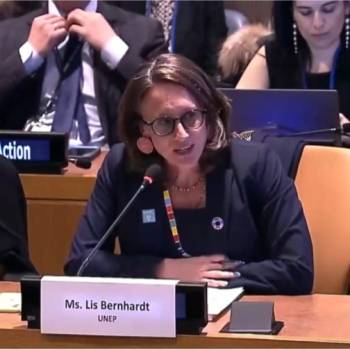
Record levels of heat-trapping gases mean further temperature increase. Carbon budget is shrinking fast. Climate change impacts include more extreme weather, sea level rise. Global Greenhouse Gas Watch will support climate action.
The abundance of heat-trapping greenhouse gases in the atmosphere once again reached a new record last year and there is no end in sight to the rising trend, according to a new report from the World Meteorological Organization (WMO).
Global averaged concentrations of carbon dioxide (CO2), the most important greenhouse gas, in 2022 were a full 50% above the pre-industrial era for the first time. They continued to grow in 2023.
The rate of growth in CO2 concentrations was slightly lower than the previous year and the average for the decade, according to WMO’s Greenhouse Gas Bulletin. But it said this was most likely due to natural, short-term variations in the carbon cycle and that new emissions as a result of industrial activities continued to rise.
Methane concentrations also grew, and levels of nitrous oxide, the third main gas, saw the highest year-on-year increase on record from 2021 to 2022, according to the Greenhouse Bulletin, which is published to inform the United Nations Climate Change negotiations, or COP28, in Dubai.
“Despite decades of warnings from the scientific community, thousands of pages of reports and dozens of climate conferences, we are still heading in the wrong direction,” said WMO Secretary-General Prof. Petteri Taalas.
“The current level of greenhouse gas concentrations puts us on the pathway of an increase in temperatures well above the Paris Agreement targets by the end of this century. This will be accompanied by more extreme weather, including intense heat and rainfall, ice melt, sea-level rise and ocean heat and acidification. The socioeconomic and environmental costs will soar.. We must reduce the consumption of fossil fuels as a matter of urgency.,” said Prof. Taalas.
Just under half of CO2 emissions remain in the atmosphere. Just over one quarter are absorbed by the ocean and just under 30% by land ecosystems like forests – although there is considerable year-to-year variability in this. As long as emissions continue, CO2 will continue accumulating in the atmosphere leading to global temperature rise. Given the long life of CO2, the temperature level already observed will persist for several decades even if emissions are rapidly reduced to net zero.
The last time the Earth experienced a comparable concentration of CO2 was 3-5 million years ago, when the temperature was 2-3°C warmer and sea level was 10-20 meters higher than now.
“There is no magic wand to remove the excess carbon dioxide from the atmosphere. But we have the tools to strengthen our understanding of the drivers of climate change through WMO’s new Global Greenhouse Gas Watch. This will greatly improve sustained observations and monitoring to support more ambitious climate goals,” said Prof. Taalas.
Global Greenhouse Gas Watch
The WMO Bulletin devotes its cover story to the Global Greenhouse Gas Watch, which was approved by the World Meteorological Congress in May. This ambitious initiative envisages sustained greenhouse gas monitoring in order to be able to account for both human activities related and natural sources and sinks. It will provide vital information and support for the Paris Agreement goal of limiting global warming to well below 2°C and aiming for 1.5°C above pre-industrial levels.
Although the scientific community has a broad understanding of climate change and its implications, there are still some uncertainties about the carbon cycle – and the fluxes in the ocean, the land biosphere and the permafrost areas.
“These uncertainties, however, must not deter action. Instead, they highlight the need for flexible, adaptive strategies and the importance of risk management in the path to net-zero and the realization of the Paris Agreement's goals. Provision of accurate, timely, and actionable data on greenhouse gas fluxes becomes more critical,” says the Greenhouse Gas Bulletin.
It cites the need for greater information about:
- Feedback Mechanisms: The Earth's climate system has multiple feedback loops, for example, increased carbon emissions from soils or decreased carbon uptake by oceans due to changing climate as illustrated for Europe for the droughts in 2018 and 2022.
- Tipping Points: The climate system may be close to so called "tipping points", where a certain level of change leads to self-accelerating and potentially irreversible cascade of changes. Examples would include the potential rapid die-back of the Amazon rainforest, slowing of the northern ocean circulation or the destabilization of large ice sheets;
- Natural Variability: The major three greenhouse gases have substantial variability driven by natural processes superimposed on anthropogenic signal (e.g., driven by El Niño). This variability can either amplify or dampen observed changes over short periods;
- Non-CO₂ Greenhouse Gases: Climate change is driven by multiple greenhouse gases, not just CO2. These gases have different atmospheric lifetimes, greater Global Warming Potential (GWP) than CO2 and uncertain future emissions.
The new Global Greenhouse Gas Watch is intended to be operational by 2028.
Greenhouse Gas Concentrations in 2022
The (NOAA) Annual Greenhouse Gas Index (AGGI) shows that from 1990 to 2022, the warming effect on our climate – called radiative forcing - by long-lived greenhouse gases- increased by 49%, with CO2 accounting for about 78% of this increase.
Table 1. Global annual surface mean abundances (2022) and trends of key greenhouse gases from the GAW in-situ observational network for GHG. Units are dry-air mole fractions, and uncertainties are 68% confidence limits.
|
|
CO2 |
CH4 |
N2O |
|
2022 global mean abundance |
417.9±0.2 ppm |
1923±2 ppb |
335.8±0.1 ppb |
|
2022 abundance relative to 1750a |
150% |
264% |
124% |
|
2021–22 absolute increase |
2.2 ppm |
16 ppb |
1.4 ppb |
|
2021–22 relative increase |
0.53% |
0.84% |
0.42% |
|
Mean annual absolute increase over the past 10 years |
2.46 ppm yr-1 |
10.2 ppb yr-1 |
1.05 ppb yr-1 |
Carbon dioxide is the single most important greenhouse gas in the atmosphere, accounting for approximately 64% of the warming effect on the climate, mainly because of fossil fuel combustion and cement production.
The 2.2 parts per million (ppm) increase in the annual average from 2021 to 2022 was slightly smaller than 2020 to 2021 and for the past decade (2.46 ppm yr). The most likely reason is increased absorption of atmospheric CO2 by terrestrial ecosystems and the ocean after several years with a La Niña event. The development of an El Niño event in 2023 may therefore have consequences for greenhouse gas concentrations.
Methane is a powerful greenhouse gas which remains in the atmosphere for about a decade.
Methane accounts for about 19% of the warming effect of long-lived greenhouse gases.
Approximately 40% of methane is emitted into the atmosphere by natural sources (for example, wetlands and termites), and about 60% comes from anthropogenic sources (for example, ruminants, rice agriculture, fossil fuel exploitation, landfills and biomass burning).
The increase from 2021 to 2022 was slightly lower than the record rate observed from 2020 to 2021 but considerably higher than the average annual growth rate over the last decade.
Nitrous Oxide is both a powerful greenhouse gas and ozone depleting chemical. It accounts for about 7% of the radiative forcing by long-lived greenhouse gases.
N2O is emitted into the atmosphere from both natural sources (approximately 60%) and anthropogenic sources (approximately 40%), including oceans, soils, biomass burning, fertilizer use, and various industrial processes.
For N2O, the increase from 2021 to 2022 was higher than that observed any time before in our modern time record.
The WMO Global Atmosphere Watch Programme coordinates systematic observations and analysis of greenhouse gases and other atmospheric constituents. Greenhouse gas measurement data are archived and distributed by the World Data Centre for Greenhouse Gases (WDCGG) at the Japan Meteorological Agency.
A separate and complementary Emissions Gap Report by UN Environment will be released on 20 November. The Emissions Gap report assesses the latest scientific studies on current and estimated future greenhouse gas emissions; they compare these with the emission levels permissible for the world to progress on a least-cost pathway to achieve the goals of the Paris Agreement. This difference between “where we are likely to be and where we need to be” is known as the emissions gap.
Sources :
WMO - World Meteorological Organization
Posted on 2023-11-22 17:58








Comments